March 7, 2008
Air Date: March 7, 2008
FULL SHOW
SEGMENTS
Taking Climate Offenders to Court
View the page for this story
Suing the corporations involved with producing greenhouse gas emissions is a new legal strategy - but will it be a successful one? Vermont Law School Professor Patrick Parenteau talks with host Steve Curwood about environmental litigation and the latest global warming lawsuit against energy companies- Kivalina v. Exxon. (05:30)
Clean Energy Future?
/ Jeff YoungView the page for this story
What do leaders in business see in our energy future? Living on Earth’s Jeff Young learns it depends which big business you ask. (06:15)
Carbon Cowboys
/ Ashley AhearnView the page for this story
Living on Earth’s Ashley Ahearn heads out to the Montana range to take a look at how ranchers are using their land to absorb the greenhouse gas carbon dioxide, and make some money on the carbon offset market in the process. (07:15)
Carbon Trading Gets Personal
View the page for this story
Some say that limiting industry’s greenhouse emissions isn’t enough; individuals need to be put on a cap and trade plan, too. Host Steve Curwood talks with Richard Starkey, a researcher with the Tyndall Centre for Climate Change Research in the UK, about a number of personal CO2 trading schemes, and the challenges to putting limits on people’s carbon emissions. (05:00)
America’s Greenest Cities
View the page for this story
Popular Science magazine released their rankings for this year’s greenest cities. Host Steve Curwood talks with Jim Hunt, chief of Environmental and Energy Services for the City of Boston, about the city’s number three rating. (05:30)
Global Weirding
View the page for this story
Listeners give us their suggestions for the terms that best describe the atmospheric changes wrought by the increase of greenhouse gases. Out with the common but, perhaps, incorrect “global warming” and “climate change.” Human consumption climate disruption, anybody? (02:15)
Frosted Gems
View the page for this story
Commentator Tom Montgomery-Fate ponders the sands of time as he collects lake glass along the Lake Michigan beach. (02:30)
Northwest Dead Zone
View the page for this story
There are about 200 oxygen depleted regions, or dead zones, in the world’s oceans. They occur when nutrients from run-off – fertilizers and manure to name a few – make it into major water bodies and cause oxygen depletion. But a dead zone off the coast of the Pacific Northwest has scientists looking at a different culprit – climate change. Host Steve Curwood turns to Professor Jack Barth of Oregon State University to learn more about what might be behind the Northwest dead zone. (06:00)
Whale Songs
/ Bruce GellermanView the page for this story
Living on Earth visits Dr. Roger Payne and Iain Kerr, whale researchers with the organization Ocean Alliance, aboard their ship “Odyssey.” In the second installment of the story, Dr. Payne talks about his whale song research and says that whale tunes have changed over the years. (05:00)
This week's EarthEar selection
listen /
download
In San Francisco Bay, a set of pipes create music when the waves roll over them,
Show Credits and Funders
Show Transcript
HOST: Steve Curwood
REPORTERS: Ashley Ahearn, Bobby Bascomb, Jeff Young
GUESTS: Jack Barth, Jim Hunt, Tom Montgomery, Patrick Parenteau, Roger Payne, Richard Starkey
[THEME]
CURWOOD: From Public Radio International – this is Living on Earth.
[THEME]
CURWOOD: I’m Steve Curwood. A native Alaskan village is suing twenty of America’s biggest energy companies, blaming them for the damaging effects of global warming that are forcing the villagers to flee their homes.
PARENTEAU: I think this case could be a breakthrough. It’ll take the same kind of breakthrough we had with tobacco. I think climate change may be at a point where we could see a similar breakthrough, and this case may be it.
CURWOOD: Also, a new cash crop out on the range for cattle ranchers: carbon credits.
STUART: It’s an extra bonus that’s needed for many of agriculturists that are spending their lives and working hard, putting their sweat on the land.
CURWOOD: And messages from the deep – the songs of whales are changing.
[WHALE SOUNDS.]
CURWOOD: We’ll have those stories and more this week on Living on Earth. Stick around!
ANNOUNCER: Support for Living on Earth comes from the National Science Foundation and Stonyfield Farm.
Taking Climate Offenders to Court
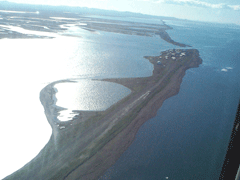
The Alaskan village of Kivalina is losing ground to erosion and rising sea levels. (Photo: U.S. Army Corps of Engineers)
CURWOOD: From the Jennifer and Ted Stanley Studios in Somerville, Massachusetts – this is Living on Earth. I’m Steve Curwood.
As the arctic melts, the coastal village of Kivalina in Alaska is falling into the sea. Soon, the four hundred or so Inupiat that live there will have to pack up and move out – a dislocation they say could cost up to $400 million. So they are suing for moving expenses. The defendants are two dozen energy companies, including ExxonMobil, BP, Peabody Energy and American Electric Power. The villagers charge the corporations with creating a public nuisance, and conspiring to mislead the public about climate change.

The Alaskan village of Kivalina is losing ground to erosion and rising sea levels. (Photo: U.S. Army Corps of Engineers)
CURWOOD: Hello there.
PARENTEAU: Hello Steve. How are you?
CURWOOD: Good. Tell me, what exactly is a public nuisance for you lawyers?
PARENTEAU: It’s a very old doctrine, which basically says one person can’t use their property in a way that unreasonably interferes with another person’s use of their property. And in this case of course the Kivalinans are essentially saying you’re destroying our entire community as a result of the greenhouse gases you are emitting. You’re doing so either deliberately and intentionally or you’re doing it negligently, but either way you’re responsible for the fact that we’re now going to have to move our community at a cost of several hundred million dollars.
CURWOOD: Professor Parenteau, I drive a car, I take hot showers, we use electricity here to run Living on Earth radio studio. Why don’t the residents of Kivalina sue me and Living on Earth for our activities?
PARENTEAU: Well, they sue the companies that have the deep pockets. That’s the answer. They’re looking for a recourse to the companies that have the money, the wherewithal to actually pay for the damage that they allege they’re causing. And it’s true that you could file a class action lawsuit against a much larger number of potentially responsible parties – that is, people that are responsible for greenhouse gas emissions – but common law, the doctrines that the Kivalinans are using in this case, basically does allow you to cherry pick. It allows you to pick out the largest and the wealthiest and say, you’re responsible and you have the means to deal with this problem and so we’re going to hold you to account.
CURWOOD: Now, these cases are perhaps somewhat reminiscent of the class action lawsuits against the tobacco industry in the 1990's?
PARENTEAU: Yes, very much so, and the claim that the Kivalinans have made – that the companies deliberately set out to deceive the public about climate change, and continue to expand their operations and put even more greenhouse gases into the atmosphere, knowing that there was pretty strong science showing that those emissions were having an adverse impact on sea level rise and other things – all of those allegations are very similar to the kinds of allegations made against the tobacco companies several decades ago.
CURWOOD: These lawsuits are often dismissed and they’re certainly criticized as being too political. What do you suppose is meant by that?
PARENTEAU: The courts want to see the legislature, either the United States Congress or perhaps state legislatures, enact some laws to give the courts some guidance on how to assign liability for something as massive as climate change. So the judge in California dismissed the lawsuit against the automakers on that basis, basically saying we courts are not competent enough to try to decide who is responsible for this problem. We want to see the political branches of the government act first.
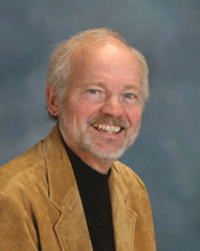
Law Professor Patrick Parenteau says the courts might eventually hold energy companies liable for damages caused by global warming. (Photo: Courtesy of Ed Chapin)
PARENTEAU: This case has a lot going for it. There still are significant legal hurdles. The courts are gonna have to decide that they can deal with these kinds of cases, that these parties have a legitimate claim to relief, that they’re not getting relief from the governments and that they can only look to the courts for relief. I think this case could be a breakthrough. It’ll take the same kind of breakthrough we had with tobacco, where the states finally brought a case after years of losing that won. And the reason they won is because they said, ‘we’re incurring these substantial costs for healthcare, never mind whether individual smokers can say that your cigarettes killed me.’ The fact of the matter is, smoking in general raised the healthcare costs, and the states got stuck with the bill for that, and the states were ultimately able to recover substantial – billions and billions of dollars for that. I think climate change may be at a point where we could see a similar breakthrough, and this case may be it.
CURWOOD: Patrick Parenteau is professor of law and senior council to the Environmental and Natural Resources Law Clinic. Thank you sir.
PARENTEAU: It was a pleasure, Steve.
Related links:
- Patrick Parenteau’s website
- Climate change in the Arctic
- To learn about other public nuisance cases, including Connecticut’s suit against utility companies, click here.
[MUSIC: Toufic Farroukh “Destins et Desirs” from Euro Groove (Putumayo Records 2008)]
Clean Energy Future?
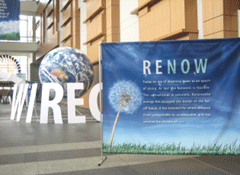
Renewable energy enthusiasts see big growth on the horizon but some doubt if wind, solar and geothermal can power replace old-fashioned coal. (Photo: Washington International Renewable Energy Conference)
CURWOOD: Renewable energy sources – wind, solar and geothermal – are growing rapidly in the U.S. But the clean energy industry warns that growth could stall, unless Congress extends tax credits set to expire at the end of the year. Venture capital investor Nancy Floyd:
FLOYD: The renewables industry globally will continue to grow, but the industry in this country will come to a virtual standstill.
CURWOOD: What Congress does today will set the country’s energy policy for decades to come. And that also means lawmakers will chart the course for our economy and the climate. They’re getting a lot of advice, especially from the CEO’s of some of the biggest companies. Living on Earth’s Jeff Young tells us those corporations don’t see eye to eye on America’s energy future.
YOUNG: Energy was at the top of the agenda when the nation’s governors met in Washington. They’re worried: they see soaring fuel costs, environmental concerns, and charts that show projected demand for power curving upward like a mountain with no peak in sight. They invited the leaders of major electric utilities to weigh in on what’s in store. Dominion CEO Tom Farrell was not encouraging.
FARRELL: I’m not an alarmist by nature. I do believe, however, that our nation is headed for an energy train wreck.
YOUNG: The wreck Farrell sees coming is when booming power demand bumps up against any aggressive global warming laws. Dominion has energy customers in 11 states. It’s planning both a new coal and nuclear plant in its home state, Virginia. Dominion’s also putting up some wind facilities. But Farrell has low expectations for alternative energy.
FARRELL: We all want a clean healthy environment. But I urge you to beware of those who say we can have it for free. They are singing a siren’s song.
YOUNG: Next, the governors heard Michael Morris of American Electric Power. AEP burns coal to generate three quarters of its electricity in the Midwest. Morris plans a new coal plant with advanced technology that could allow it to capture CO2 and store it underground. He warned against any action that would cut the use of coal.
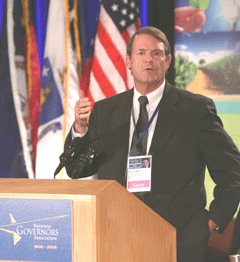
American Electric Power’s Michael Morris warns governors that the idea of reducing the use of coal is “something we should all be frightened by.” (Photo: Washington International Renewable Energy Conference)
MORRIS: And the whole notion of de-legitimizing coal is something that we should all be frightened by. Coal is our biggest resource and something that we need to lean on and lean on as hard as we can as we go forward.
YOUNG: The governors apparently got the message. They chose not to act on a modest global warming resolution by Minnesota Governor Tim Pawlenty. But the message was quite different at another energy gathering in Washington.
[APPLAUSE]
HAYWARD: Ladies and Gentlemen, good morning. It’s a great pleasure to be at third international renewable energy conference.
YOUNG: Tony Hayward’s company BP helped sponsor the year’s biggest gathering of government officials and renewable energy businesses. BP invested a billion dollars in renewables last year and plans one point five billion in ‘08, a lot of it in the U.S. BP owns the most wind power acreage and runs the country’s largest solar equipment facility.
HAYWARD: America is the world’s biggest energy consumer, and any serious change in global energy consumption patterns has to begin here.
YOUNG: Hayward wants Washington to pass a law to put a price on carbon emissions. That would make cleaner sources, now much more expensive than fossil fuels, more attractive. Electricity from wind is now about 50 percent pricier than that from coal; solar is from three to five times as costly as coal.
A lot of companies are working to bring down those costs, including some not even in the energy business, like Google. The information technology giant recently launched a campaign that goes by an engineering formula: RE less than C –that’s renewable energy less than coal.
REICHER: So we’ve set ourselves a pretty aggressive goal, which is to make renewable electricity, from solar to wind to geothermal, cheaper than coal.

Renewable energy enthusiasts see big growth on the horizon but some doubt if wind, solar and geothermal can power replace old-fashioned coal. (Photo: Washington International Renewable Energy Conference)
YOUNG: That’s Dan Reicher. He took over Google’s energy initiatives after eight years in President Clinton’s energy department. Google’s putting engineers, scientists and investment capital to work on potential breakthrough technologies in clean energy. And Reicher sees a role for Google’s better known pursuits on the net.
REICHER: What can we do with Google earth and Google maps and You Tube to really get the word out about renewable electricity.
YOUNG: I hear from folks in the electric utility industry that we’d be fools to turn our backs on coal. What do you think? Can you envision this country without coal in the near future?
Reicher: Coal is not going away anytime soon, but what renewable electricity combined with energy efficiency offers is the chance to slow down the growth of coal and to begin to wean ourselves off existing coal-fired power plants.
YOUNG: Google has big ambitions, but I wanted the really big business picture, and business doesn’t get much bigger than GE. GE Energy’s Vice President for renewables, Victor Abate, says the company’s invested billions in alternative energy and sees tremendous growth on the horizon. He expects wind, now just a little over one percent of the U.S. electricity mix, to be five or ten times that.
ABATE: Right around the corner – 2015, 2020. The size could be five, ten percent without too much of a stretch in our view.
YOUNG: Who’s right, here? The boosters on the renewables side or the fossil fuel folks?
ABATE: Our view is they’re both right. We’ve for the past hundred years built a power generation infrastructure of about a thousand gigawats. The question is for the next 100 years what’s the next thousand look like? And that mix we think is going to be dramatically different. You’ll still need coal, gas, and nuclear and we’re investing in those. But the percentage of renewables won’t be one percent.
YOUNG: Want more windmills? GE can make them. And who supplies equipment for the coal and nuclear plants AEP and Dominion want to build? That’s right – GE. It’s one of the little perks of being one of the world’s largest corporations: they profit no matter what energy course the country chooses. For Living on Earth, I’m Jeff Young in Washington.
Related links:
- Check out LOE’s series on coal
- More about Google’s energy initiative, RE
- General Electric’s renewable energy site, “ecomagination”
- American Electric Power’s plans for high-tech coal plants
[MUSIC: Jazzamor “Nuit Magique” from Euro Groove (Putumayo Records 2008)]
CURWOOD: Coming up – home on the range, where the deer and the carbon credits play. Keep listening to Living on Earth.
Carbon Cowboys

Court Smith of Beartooth Capital, drives out to Sun Ranch in Cameron, Montana. (Photo: Ashley Ahearn)
CURWOOD: It’s Living on Earth. I’m Steve Curwood. The United States may have opted out of mandatory limits on global warming gases under the Kyoto Protocol, but there is a thriving market in credits for voluntary reductions of greenhouse gases. Much of it takes place at the Chicago Climate Exchange. Running a political campaign that’s racking up emissions from jetting around the country? That’s okay – brokers for the exchange can sell you carbon offsets, credits generated by operations that have reduced carbon emissions below the present norm. Many of these carbon credits come from collecting methane from landfills, planting trees or installing clean energy such as wind turbines. And now cattle ranchers are cashing in as well. Living on Earth’s Ashley Ahearn has our story from Cameron, Montana.
AHEARN: Court Smith and Todd Graham know what it’s like to feel a bit out of place. When they pull up at a ranch and tell the ranchers they pretty much want to pay them to boost the CO2 their land is already absorbing from the air - well, Smith says they’re usually just crossin’ their fingers they don’t get run out of the county.
SMITH: If it doesn’t sound like you’re sellin’ snake oil, I don’t know what else would be. You know, I got some air I wanna sell, and so it’s a very complicated system for your average person to grasp because it’s just so new.
AHEARN: As carbon brokers for a company called Beartooth Capital, they work with ranchers to increase the amount of CO2 the soil on their ranches absorbs. Then Smith and Graham sell credits for that CO2 on the Chicago Climate Exchange.
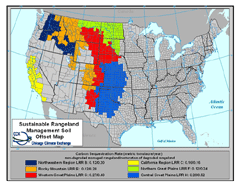
A regional map of CO2 absorption in the U.S. (Photo: Chicago Climate Exchange)
[CAR DOOR SLAMMING; DOGS BARKING; GATE OPENING]
AHEARN: Great weather today.
GRAHAM: Fairly typical, for January in the Madisons.
AHEARN: We’re about an hour and a half south of Bozeman, Montana, at the first and only ranch to sell credits to the Chicago Climate Exchange. Farm dogs bark and a couple of horses in the corral look up as we come through the gate.
It’s called Sun Ranch, but today, there’s a blizzard on.
WOMAN: C’mon in!
MAN: Hey!
STUART: My name is James Stuart and we are on the Sun Ranch in Cameron, Montana. Right now we’re down by Wolf Creek in my house.
STUART: This is Emma and this is Christian.
[LITTLE KID YELLING]
AHEARN: James Stuart manages Sun Ranch. Christian, his three-year-old, is all worked up because he’s coming out for a ride in the pick-up to show us what his daddy does.
[DOOR CLOSING, CAR STARTING]
AHEARN: As we drive up into the rangelands of Sun Ranch, James Stuart’s voice traces the land formations as he points through the windshield and drifting snow.
STUART: Alright, this is about the middle of the ranch. Our property will go up from the foothills a ways. We have Wolf Creek to the North, we have Moose Creek coming down out if this big canyon, and then…
AHEARN: The ranch covers about 26,000 acres of rolling range and the more grass grows, the more carbon gets pulled out of the air and stored in the soil. James Stuart now runs no more than 2,600 cattle, rotating them around the property throughout the year. He used to run twice that many. This ranch could afford that loss of income because the current owner came in with money to invest in making the ranch more sustainable.
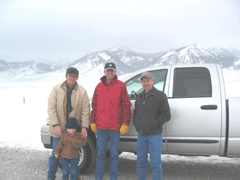
Rancher James Stuart (left) and his son Christian (center left) take Todd Graham (center) and Court Smith (right) on a tour around Sun Ranch in the blizzard. (Photo: Ashley Ahearn)
BROWN: There is a lot of work that has to go into the documentation of the productive capacity of that land, the current condition that it’s in, the historical practices over the past and then some agreements on monitoring and the kind of adjustments they’ll make in response to changes in climate.
AHEARN: Brown is the guy the Climate Exchange went to when it first wanted to put a dollar value on CO2 in grasslands. And he told them not all grasslands are created equal.
BROWN: A very important part of carbon sequestration is climate, in particular, rainfall. That rainfall is what gets plants to produce. As those plants produce more biomass, more of it’s transferred below the ground and can be stored as carbon.
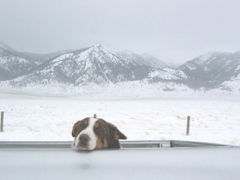
B the head farm dog enjoys a snowy ride in James Stuart's pick up. (Photo: Ashley Ahearn)
Brown and a team of scientists divided the country into regions and assigned a value to each one. The Sun Ranch falls in a region that absorbs .2 tons of CO2 per acre.
I asked Michael Walsh, Vice President of the Chicago Climate Exchange, to help me figure out how much money Sun Ranch gets for the carbon it absorbs every year.
AHEARN: So I did a little math, 26,000 acres times .2 that’s about 5,200 tons of CO2, so then, where do I go from here in terms of calculating that check?
WALSH: Well the 5,200 tons are currently worth approximately 20,000 dollars a year. They’re selling for about $4.25 a ton and you convert the tonnage into sales price and your check comes after you execute the sale.
AHEARN: 20,000 bucks, 5,200 tons. To the Climate Exchange, that’s peanuts.
WALSH: Now that said, it may be a small piece of the solution set, but it can be a significant opportunity for the landowner that undertakes these best management practices.
AHEARN: Sun Ranch got a check that about equaled a quarter of its annual income. And that wasn’t peanuts to James Stuart.
[TRUCK SOUNDS]
STUART: It’s an extra bonus that’s needed for many agriculturists that are spending their lives and working hard, putting their sweat on the land.

A blizzard on Sun Ranch in Montana's Madison Range. (Photo: Ashley Ahearn)
STUART: Our average age of our agriculturists are, it’s above 60 in the United States, and so we really need to work on encouraging youth to get back into agriculture.
AHEARN: The Stuarts have worked hard to raise their kids to love ranching. So far three-year-old Christian Stuart seems pretty happy helping Dad out on the range – even if it’s just by shifting gears in the pick-up.
STUART: Okay, shift for me…There you go.
[CAR ACCELERATES]
STUART: Tell ‘em all the stuff that you’ve seen on this ranch. What are the wildlife that you’ve seen?
CHRISTIAN: One mommy and two babies.
STUART: Mommy and baby what?
CHRISTIAN: Bears.
STUART: Oh bears, what else have you seen?
CHRISTIAN: And I’ve seen a wolf, one daddy wolf and I’ve seen a badger and a baby antelope. I’ve seen a bunch of daddy deer.
STUART: But how do you know if it’s a dad?
CHRISTIAN: Because. I just tell them when I saw one.
STUART: What does it have?
CHRISTIAN: Horns and stuff.
STUART: (laughing) Horns and stuff.
AHEARN: Christian just got his first pony for Christmas, because mom got tired of having a back-seat rider when the family was out herding cattle. He’s a paint gelding Christian Stuart named Paint.
The new rangelands program may never get off the ground, depending on federal carbon policy. But if it does, it could give Christian Stuart, and other young ranchers, the chance to have back-seat riders of their own someday.
For Living on Earth, I’m Ashley Ahearn in Cameron, Montana.
Related links:
- Chicago Climate Exchange's Rangelands Program
- Beartooth Capital
[MUSIC: Robert Plant & Allison Krauss “Your Long Journey” from Raising Sand (Rounder Records 2007)]
Carbon Trading Gets Personal
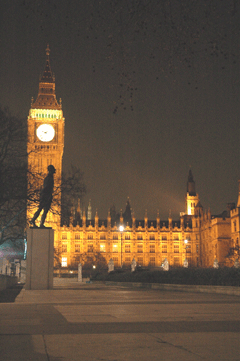
If the UK opts for a carbon tax, the Houses of Parliament and Big Ben will face a bill for their flood lights. (Photo: Dan Grossman)
CURWOOD: Big business generates a lot of climate changing gases, but then, so do individuals. In the UK, 40 percent of CO2 emissions come from ordinary citizens who are the end users of fossil fuels. So there are several proposals to give plain folks some direct incentives to reduce their carbon waste. One option is a carbon tax – you use more, you pay more. Another idea would be carbon allowances that people could sell if they didn’t use them. At the Tyndall Centre for Climate Change Research in England, Richard Starkey is working on a scheme called the Domestic Tradeable Quota. Each citizen would get a sort of carbon debit card that would record exactly how much fossil fuel they use for transport and in their home. Mr. Starkey joins me now from Manchester, England. Welcome to Living on Earth.
CURWOOD: This sounds a bit like Big Brother.
STARKEY: Well this is one of the objections that people make to this sort of idea. There would be this great big database, everybody would have an account in this database, and that the state would be able to know when you bought your gas, how much you bought, how much you paid. And obviously civil liberties in this country, as in the States, are very important. And so if a scheme like this was ever to be implemented, then there would have to be very stringent safeguards about how much data the government was able to collect on individuals and who was able to see that data. But I think you’re absolutely right, any scheme like this, if it’s going to work, has to be privacy friendly.
CURWOOD: So under your scheme I’d get something like what, a World War II ration card, that – I mean, I could trade that, right? If I didn’t want to use the emissions I could sell it to somebody else or give it to my cousin or something?
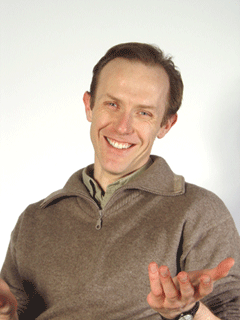
Richard Starkey from the Tyndall Centre for Climate Change Research in England. (Photo: Tyndall Centre for Climate Change Research in England)
STARKEY: Yeah that’s a really good point that you make. This would actually be very different from World War II rationing, because the rations that you got in the Second World War were non-tradable. But what you would be getting under this scheme is a tradable ration. So if you’re a low emitter, perhaps if you don’t drive very much, if you’ve got a very well insulated house, if you use efficient appliances, you’d have some spare emissions rights left. And so you could sell those on the national market to people who have higher emissions, and so who needed to buy higher emissions rights to emit at a higher level. And so that there would be a market in emissions rights, and so individuals would be carbon traders.
CURWOOD: A number of details to something like this. What about somebody who has, say, three kids as opposed to somebody who has no kids? And then they drive them to the soccer match and all that sort of thing. One adult, one set of emissions, doesn’t matter how many kids you have?
STARKEY: That’s a really good question you ask. I think for some people, the idea that every adult gets the same quantity of emissions rights is very appealing. But as you say, when you think about it first, some rather awkward questions keep coming up. Well, what happens if someone lives in a very cold part of the country where they need more fuel for heating? And if they need more fuel they produce more emissions. I think there are two ways of approaching it. Either you go for the commons argument and say, ‘well because we all share the atmosphere, everybody owns it equally, therefore everybody is entitled to emit equally.’ Perhaps the other argument you could make it, well look, if we had to adjust everybody’s allowance for everybody’s individual circumstances, then it would be horrifically complicated for government.
CURWOOD: How do these various schemes keep things equitable between poor people who don’t have a lot of money to pay for an extra carbon tax or emission right, and rich people, who certainly could well afford such a thing?
STARKEY: Generally speaking, poor people emit much less than rich people, so under this scheme everybody, if you like, gets an average quantity of emissions rights. But generally speaking, less well-off people emit at a below average level, whereas more well-off people emit at an above average level. So if you like, it’s a scheme that’s friendly to those on lower incomes.
CURWOOD: As long as they don’t have to drive very far to get to that poor-paying job.

If the UK opts for a carbon tax, the Houses of Parliament and Big Ben will face a bill for their flood lights. (Photo: Dan Grossman)
CURWOOD: Richard Starkey is a research fellow with the Tyndall Centre at the University of Manchester in England. Thank you so much, Mr. Starkey.
STARKEY: It’s a real pleasure.
CURWOOD: Happy driving. I hope you have the quotas for it.
STARKEY: [laughs] Thank you very much.
Related links:
- The Tyndall Centre for Climate Change Research
-
[MUSIC: Sting and The Police “Every Breath You Take” from Greatest Hits of Sting and The Police (A&M Records 2002)]
America’s Greenest Cities

Boston has been ranked the greenest city on the Eastern Seaboard. (Photo: Boston University)
CURWOOD: Popular Science Magazine says Portland, Oregon is the greenest city in America, with San Francisco close behind. And given Portland’s greenbelt and great public transportation, and the Fog City’s dedication to just about all things green, that’s no surprise. But when you look down Pop Sci’s list of the 50 greenest cities in America, guess who comes in at number three: Boston, Massachusetts. Now some disclosure here: Boston is my hometown, so there’s some pride. But let’s face it: not so long ago Boston Harbor reeked of pollution and the main drag through downtown was a rusting elevated disaster zone – less a road and more a monument to mindless sprawl and congestion. But now, according to Popular Science, Boston is the greenest city on the eastern seaboard. Joining me from City Hall is Jim Hunt, Boston’s Chief of Environmental and Energy Services. So Jim, Bean Town is a green town?
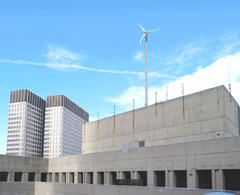
Rendering of a roof mounted with a wind turbine, which the city of Boston plans to put on top of City Hall. (Photo: the City of Boston)
CURWOOD: Now there was one very green project in Boston that the world knows about, green in terms of a lot of money. And that’s the Big Dig, what some 14 and a half billion dollars. How green was that deal?
HUNT: Well one of the outcomes of the Big Dig project was to improve transportation infrastructure, but also to reconnect our city to our waterfront and adding over 20 acres of green space through the Rose Kennedy Greenway, so it’s a great connection between our Boston Common and the Emerald Necklace park system down to our waterfront, which we’ve made great strides in cleaning up, the Boston Harbor.
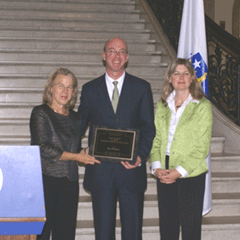
Jim Hunt (center), Boston’s chief of environment and energy, receives Massachusetts Governor Deval Patrick’s “Leading by Example Award” for innovation in clean energy and sustainability. (Photo: the City of Boston)
HUNT: Well, we have an aggressive composting program, a leaf and yard waste collection program, as part of our recycling initiative to divert waste from being landfilled or incinerated, and put it back to productive use in our community gardens and our park spaces. But that composting process also off-gases greenhouse gases, both methane gas and carbon dioxide. So with the price of oil at over 100 dollars a barrel, gasoline over three dollars a gallon, and electricity here in the Northeast at very high costs, now seemed the right time to try to capture some of those biogases that come off of our compost and put it back to domestically-produced green energy.

Boston Mayor Thomas Menino gets into one of Boston’s clean air hybrid cabs. (Photo: City of Boston)
HUNT: Well, I think because of our dense development here in the city and our efficient use of energy and materials, as well as the new strategies that we’ve been implementing, from renewable energy, energy efficiency, recycling, and innovative programs like our composting to biogas generator.
CURWOOD: Jim Hunt, what would you have Boston do to move up the scale next year, perhaps be number two or even number one on the scale of the greenest city in America?
HUNT: Well, there are different shades of green, and Boston has a long way to go frankly, and we have ambitious plans, particularly in the area of energy efficiency. We need to bring the leadership that the city has been able to do on our own buildings, out to our private residential folks. Also in the area of waste management, we can always do better and recycle more, and we have programs geared doing that. Lastly, any city can improve on transportation. We have to address single-occupancy vehicle use into our cities that not only contribute to global warming but can exacerbate respiratory ailments like asthma. And so to the extent that we can make investments in mass transit, in intermodal, connections to biking and pedestrian connections – those are things that we’re working on to become even greener.
CURWOOD: Jim Hunt is the chief of environmental and energy services for the city of Boston. Thanks, Jim.
HUNT: Alright. Take care.
CURWOOD: Boston comes in number three on Popular Science’s list of America’s greenest cities. At the top, Portland, Oregon, then San Francisco. For the rest of the list, go to our website L-O-E dot O-R-G.
Related links:
- Popular Science’s list of the country’s 50 greenest cities
- The city of Boston’s Department of Environmental & Energy Services webpage
[MUSIC: Wampeters “Twilight In Boston” from If I Were A Richmond: A Tribute To Jonathon Richmond (The Orchard Records)]
CURWOOD: And just ahead, why those that go down to the sea in ships might find there’s a lot missing.
BARTH: Next thing you notice is there aren’t any fish in the area. So in all of our surveys in ’06, we did not see any fish in this zone. Then you notice the piles and piles of dungeonous crab carcasses on the sea floor. Amongst them are sea worms that have come out from the bottom and are just flapping in the currents. Some of these majestic anemones, white, about two feet tall, starting to slump over from lack of oxygen.
CURWOOD: Stay tuned to Living on Earth.
ANNOUNCER: Support for the Environmental Health Desk at Living on Earth comes from the Cedar Tree Foundation. Support also comes from the Richard and Rhoda Goldman fund for coverage of population and the environment. This is Living on Earth on PRI: Public Radio International.
Global Weirding
CURWOOD: It’s Living on Earth. I’m Steve Curwood. And now, a few words from our listeners.
[LETTERS THEME]
CURWOOD: A couple of weeks ago, we asked you if you could come up with better terms than ‘global warming’ and ‘climate change.’ You certainly had some ideas.
IAN QUIRK: I think it should be climate imbalance, which implies some places are gonna get much hotter and some places are gonna get much colder, but either way we have no way of predicting how that's going to happen.
BONNIE BISHOP: What to call global warming instead global warming? And from the beginning, I've said we should call it global trauma.
LEON FROM CHICAGO: The topic of the climate change, how it should be called – well, it should be called climate change.
MARTIN SLOVINSKY: Human consumption climate disruption; human consumption climate disruption
CURWOOD: Your e-mails also think ‘global.’ There was ‘global life system instability’ and ‘global climate disruption,’ ‘global climate damage’ and ‘global climate melt-down.’ One writer suggests ‘global temperature destabilization,’ noting that it's ‘harder to say and spell, but more descriptive.’ Also pretty hard to say is this offering – anthropogenic climate disruption. And still the phones kept ringing off the hook:
PETER WALE: In our household, when we run into difficulties with the terms global warming or climate change, we resort to a more technical term, ebbifluid acceleration.
AHMEEL MERRITT: How about we call it global abuse.
ANNA VON BILLINGEN: The new suggestion for what we're calling how we're trashing our planet would be global dumping.
CARBON INFUSION: I heard a good one. It sounds right to me – carbon infusion. Deadly carbon infusion.
CURWOOD: Many thanks to all who took the time to call and write, including Ian Quirk, Anita Schnee, Martin Slovinsky, Ahmeel Merritt, Bonnie Bishop, Jack Ciak, Peter Wale, Terry Watts, and Anna Von Billingen. We're always glad to hear from you. You can call our listener line any time at 800 218-9988. That's 800-218 99 88. Or you can always write to us at Living on Earth, 20 Holland Street, Somerville, Massachusetts 02144. Our e-mail address is comments at LOE dot org. Once again, comments at LOE dot org. And visit our web page at L-O-E dot O-R-G. That's L-O-E dot O-R-G.
Frosted Gems
CURWOOD: As winter begins to loosen its grip on the north of the country, the world outdoors becomes increasingly inviting. Commentator Tom Montgomery-Fate loves to comb the beaches of Lake Michigan. And the jewels he finds there remind him that our resilient earth can turn some of our trash into treasure.
MONTGOMERY: Here in the Midwest the Great Lakes are our ocean, our seashore. For me, it’s Lake Michigan, which is about two miles from our farm. Since it’s too cold for swimming now, I'm always looking for another reason, or excuse, to wander the dunes and comb the beaches. My favorite excuse is glass hunting.
When I walk the shoreline I pick up and throw away any sharp jagged pieces I find which might cut some unsuspecting beach stroller. But what I’m really looking for is what this trash becomes – the treasure of lake glass – those shards tumbled into frosted gems by the rhythm of stone and water.
Most of the pieces of lake glass I have found over the years are clear or brown or green; they range in size from a thumb-nail to a half dollar. The most valuable pieces are the most worn, pitted, and opaque. The beauty of lake glass stems from its seasoning, from how rough and rounded and cloudy it is. Each piece is a wordless story read with the palm and fingers.
Glass can be recycled endlessly, from glass to sand to glass and back again. The fragments of a broken bottle or jar are worn down by the hour and day and decade – by rock and sun, by the undertow and rip tides, the lateral tug and pull of the waves. The shards of glass, the garbage carelessly tossed on the ground, slowly re-turns to their origin, to granules of sand; the broken bottle becomes the beach again. In time, if undiscovered by someone like me, even the most beautiful pieces of lake glass will also disintegrate back into the sandy beach.
This is the miracle of lake glass: the gem maker, the mindless lake, teaches the junk maker, the rational human, how to belong to the cycle of nature, how to heal what we have poisoned, how to live in another kind of time, how to see.
CURWOOD: Tom Montgomery-Fate teaches writing at College of DuPage in Glen Ellyn, Illinois. He’s the author of “Steady and Trembling: Art, Faith and Family in an Uncertain World.”
Related links:
- Tom Montgomery-Fate, Professor of English
- Other writings by Tom Montgomery-Fate
[MUSIC: The Bad Plus “Heart of Glass” from Blunt Object (Radio Promo only) (Sony Records 2005)]
Northwest Dead Zone
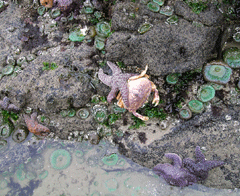
Seastars feasting on Dungeness crabs that succumbed to low oxygen conditions during 2004. Dungeness crabs are not a normal part of the diet of tidepool seastars. (Photo: Jane Lubchenco)
CURWOOD: We like to picture the ocean as teeming with life – fish and crabs and strange glowing eels, that sort of thing. But in many parts of the world the ocean is dying. There are currently about 200 dead zones, almost all of them caused by fertilizer or sewage run-off. But one dead zone off the coast of the Pacific Northwest has been expanding over the past few years, for causes that are harder to fix. Joining me now is Professor Jack Barth of the College of Oceanic and Atmospheric Sciences at Oregon State University. Professor Barth, welcome to Living on Earth.
BARTH: Thank you, Steve.
CURWOOD: So the news is, the dead zone off of the Pacific Northwest might well be connected to climate change. How and why would that be?
BARTH: Well, we’ve seen low oxygen or hypoxia in these areas where there is significant green life die-off, so-called dead zones. We’ve seen that over the past five or six years, and we think that’s unusual on the backdrop of about a fifty year’s worth of data. So we’re looking towards the cause, and we think there’s a hint in the winds and how they’re changing and how that affects these dead zones.

Screen capture showing carcasses of marine worms, sea cucumbers, crabs and other marine life killed by the loss of oxygen in nearshore reefs. (Photo: Oregon Department of Fish and Wildlife ROV)
BARTH: Well, this one’s unusual because it’s on an open coastline. It should be flushed regularly. There are no rivers putting nutrients in – that’s the cause of most of the hypoxia zones around the world. Well it’s all connected to the winds. The winds blow on the coast, they bring up these deepwaters from offshore, right in next to the coast. That fuels these phytoplankton blooms that then decompose and pull the oxygen out of the water. So we can go back to the winds, are the winds changing. And we know that with climate change there can be changes in the wind. Particularly they can increase in strength, so this whole scenario where we’re producing lots of plankton that can decompose, that might be worse as we go into a climate change scenario.
CURWOOD: Why isn’t this, you know, just something that’s cyclical, that every ten or twenty, or maybe every fifty years this happens, the way you get other oscillations in the ocean, like the whole El Niño/La Niña phenomenon?
BARTH: Yeah, we were quite interested in that. There’s a big ten year change out here in the Pacific, and when we first saw this we said, ah ha that’s just one of these ten year swings. But having gone back over that fifty year record, this recent five or six years really is unusual. So I can tell you that it’s not part of a decadal, or a ten year oscillation. Whether it’s fifty or a hundred years, we don’t know.
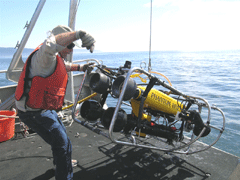
Dr. Hal Weeks deploying an Oregon Department of Fish and Wildlife robotic remotely operated vehicle to survey the effects of low oxygen zones along the Oregon coast. (Photo: Jane Lubchenco)
BARTH: Well, first thing you notice, there’s lots of something called marine snow, this white, flocky material coming down from the surface. That’s the plankton falling down that’s gonna be decomposed and lead to the hypoxia. Next thing you notice is there aren’t any fish in the area. So in all of our surveys in ’06, we did not see any fish in this zone. Then you notice the piles and piles of dungeonous crab carcasses on the sea floor. Amongst them are sea worms that have come out from the bottom and are just flapping in the currents. Some of these majestic anemones, white, about two feet tall, starting to slump over from lack of oxygen. There usually are lots of sea star species. We saw some of those actually collapsing from lack of oxygen – so basically this wholesale area of nothing alive and lots of death.
CURWOOD: Going over a couple of articles written about your research, there was a story of some fisherman having crabs kind of jumping out of the water there? What’s that all about?
BARTH: Yeah, what happens is those that can get away do. And what I saw myself is, my son and I go recreational crabbing, and we were in the bay near the dead zone and catching phenomenal sized crabs, sort of dinner plate sized in fifteen minutes or less. And those were the crabs that were running into shore, running into shallow water where there is oxygen. I’ve also heard reports of small octopi coming up the lines of the fisherman, trying to get out of that dead zone near the bottom of the water.
CURWOOD: And this isn’t happening just off the Pacific Northwest. This is elsewhere on the planet.

Seastars feasting on Dungeness crabs that succumbed to low oxygen conditions during 2004. Dungeness crabs are not a normal part of the diet of tidepool seastars.
(Photo: Jane Lubchenco)
CURWOOD: So what an irony this is. The wind blows in too much food for the fish, and actually if people are in the area, the fish, in fleeing the dead zone as that too much food decays, also they get this huge bounty. So we’re getting this inverse signal from nature that a lot of nutrient and, over the short term, a lot of seafood.
BARTH: Yeah, that’s exactly right. If you think about this whole process as fueling a healthy ecosystem, there was a balance there and now somehow we’ve pushed that a little too far, and as these dead zones develop the creatures are fleeing to the edges looking for oxygen refuges and concentrating, and we’re really not sure what the ripple effect will be – will they be more subject to being preyed upon in those areas?
CURWOOD: Professor Jack Barth teaches at the College of Oceanic and Atmospheric Sciences at Oregon State University. Thanks so much, Jack.
BARTH: You’re welcome, Steve.
Related link:
Click here to see more photos and read the Oregon State University team's work
Whale Songs
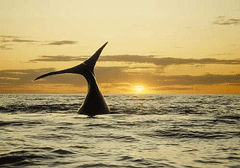
A Southern Right Whale uses its fluke in the wind as a sail, an activity understood to be whale play. (Photo: Iain Kerr)
[WHALE SONG]
CURWOOD: We recently reported on the Ocean Alliance research vessel Odyssey, which travels the world to collect blubber samples from whales. The Odyssey also collects recordings of whales singing, continuing the work that Roger Payne, president of Ocean Alliance, started more than 40 years ago.
[WHALE SONG]
CURWOOD: And Dr. Payne says he’s noticed that, over the years, the whales have changed their tunes.
PAYNE: The sounds of this particular one were recorded in about 1961. They are more beautiful I think than any sounds that have been made since.
[WHALE SONG]
These animals change their songs so that after five years you have a totally different song from what you had before. And that means that as time goes by the song drifts into new territory. What it’s in now is, it’s alright, it’s interesting, and it’s quite lovely, but it’s not this same keening extraordinary cries that just fill your heart as well as the air.
[WHALE SONG]
This is about ten years later, and it is also in exactly the same place, the same species, but now nothing like this was present in the ones that you heard just a moment ago.
[WHALE SONG]
The whales slowly accumulated a bunch of differences until they began to sing this song.
[WHALE SONG]
I think what probably happens is somebody invents a new phrase in the song and if it is popular with females – because I suspect, although I can’t prove that that is its principal function – then what it would do is, other males would observe, oh my gosh he’s doing better than I am, and they would go off and copy the same thing to gain the same advantage.
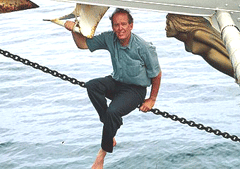
Roger Payne says not only do whale songs feature musical phrases, rhymes, and yodeling, they also change over time. (Photo: Iain Kerr)
[MUSIC AND WHALE SONG]
They mix about the same degree of percussive noisy sounds with melodic pure tones. They also do strange things like doing A-B-A form, where they make a statement, a musical statement, then they shift to another one, then they return to the first one.
[WHALE SONG]
Now that’s one phrase, and the whale repeats its phrase and sort of yodels the second time. Here, I’ll show what I mean.
[WHALE SONG]
Now if we had time, we would listen to that whale do many many iterations of that one theme, and then eventually it would change what it was doing and make something completely different, and it would do that for a while, oh, and then it would change again, and do a third and a fourth and a fifth, up to nine times in some songs. So it’s an interesting – it takes a long time to hear a whale song.
[WHALE SONG]
You can’t rush a whale. They also use rhyme in their songs. That is the same trick that the old troubadours used to do in order to remember epic poems, is they included rhyme. It’s a mnemonic device, a thing that allows you to remember what comes next.

A Southern Right Whale uses its fluke in the wind as a sail, an activity understood to be whale play. (Photo: Iain Kerr)
And now the question to me is, why, how possibly is this the case? There’s not a chance that whales were aware of humans or humans were aware of whales. And yet they are using the same tricks. My suspicion is, is that the vertebrate brain, whether it’s located in the head of a whale or the head of a human being, is entertained by pretty much the same kinds of things.
[WHALE SONG]
To me that suggests the following: that music is probably older than our species, a lot older than our species. That basically there was a common ancestor to humans and whales at least when it comes to music, and that these laws got passed through a whole chain of species in both cases and finally have ended up in us, and that these use the same sorts of tricks to gain whatever their final gain is. My suspicion is to the attraction of a female.
[WHALE SONG]
CURWOOD: Roger Payne, expert interpreter and collector of whale songs, and President of the Ocean Alliance. Our story was produced by Bobby Bascomb and Bruce Gellerman.
[WHALE SONG; All Whale song samples were provided by Dr. Roger Payne]
Related link:
Ocean Alliance website
CURWOOD: Next time on Living on Earth – Saguaro National Park and the hills of Tucson, Arizona have an uninvited visitor that’s threatening to take over.
BETANCOURT: Do you see that patch over there, next to Pima Canyon? Buffelgrass. You start looking down the mountain, you start picking out all these little patches. And that’s all buffelgrass, and eventually, the whole ridge will be buffelgrass.
CURWOOD: Invasion of the invasives, on the next Living on Earth.
CURWOOD: We leave you this week with a set of musical pipes.
[EARTHEAR: Catherine Girardeau, Track 68 from ‘Day of Sound’ Earth Ear Record Releases]
CURWOOD: On a peninsula in San Francisco Bay sits the Wave Organ. It’s an acoustic sculpture. As the waves roll ashore, the organ’s twenty-five pipes create these musical tones. Catherine Girardeau recorded the water music, and it’s included on the Earth Ear CD, ‘Day of Sound.’
CURWOOD: Living on Earth is produced by the World Media Foundation. Our crew includes Ashley Ahearn, Bobby Bascomb, Eileen Bolinsky, Jackson Braider, Bruce Gellerman, Ingrid Lobet, Helen Palmer, Mitra Taj, and Jeff Young. Our interns are Annie Jia and Margaret Rossano.
Jeff Turton is our technical director. Alison Lirish Dean composed our themes. You can find us at L-O-E dot org. I’m Steve Curwood. Thanks for listening.
ANNOUNCER: Funding for Living on Earth comes from the National Science Foundation, supporting coverage of emerging science and Stonyfield Farm, organic yogurt and smoothies. Stonyfield Farm pays its farmers not to use organic growth hormones on their cows. Details at Stonyfield.com. Support also comes from you our listeners, the Ford Foundation, the Town Creek Foundation, the Oak Foundation, supporting coverage of climate change and marine issues, and Pax World Mutual Funds, socially and environmentally sustainable investing. Pax World: for tomorrow. On the web at paxworld.com.
ANNOUNCER: PRI: Public Radio International.
Living on Earth wants to hear from you!
Living on Earth
62 Calef Highway, Suite 212
Lee, NH 03861
Telephone: 617-287-4121
E-mail: comments@loe.org
Newsletter [Click here]
Donate to Living on Earth!
Living on Earth is an independent media program and relies entirely on contributions from listeners and institutions supporting public service. Please donate now to preserve an independent environmental voice.
NewsletterLiving on Earth offers a weekly delivery of the show's rundown to your mailbox. Sign up for our newsletter today!
 Sailors For The Sea: Be the change you want to sea.
Sailors For The Sea: Be the change you want to sea.
 The Grantham Foundation for the Protection of the Environment: Committed to protecting and improving the health of the global environment.
The Grantham Foundation for the Protection of the Environment: Committed to protecting and improving the health of the global environment.
 Contribute to Living on Earth and receive, as our gift to you, an archival print of one of Mark Seth Lender's extraordinary wildlife photographs. Follow the link to see Mark's current collection of photographs.
Contribute to Living on Earth and receive, as our gift to you, an archival print of one of Mark Seth Lender's extraordinary wildlife photographs. Follow the link to see Mark's current collection of photographs.
 Buy a signed copy of Mark Seth Lender's book Smeagull the Seagull & support Living on Earth
Buy a signed copy of Mark Seth Lender's book Smeagull the Seagull & support Living on Earth

